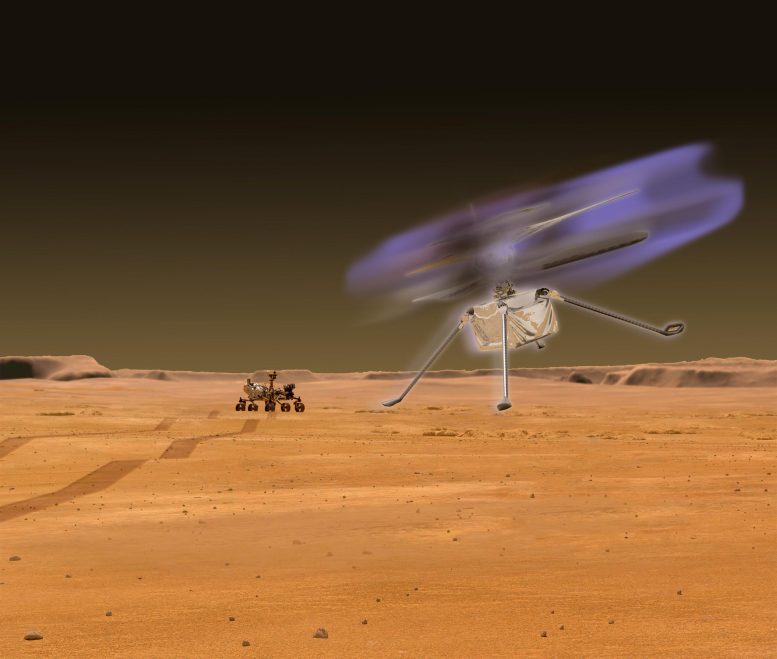
This is an artist’s concept of a glow surrounding a drone at Mars during flight. The glow, exaggerated for visibility, might happen if the drone’s spinning rotor blades generate an electric field that causes electric currents to flow in the Martian air around the craft. Although the currents generated by the drone in the atmosphere are small, they might be large enough to cause the air around the blades and other parts of the craft to glow a blue-purple color. Credit: NASA/Jay Friedlander
If the Ingenuity helicopter would fly at night on Mars, its very possible the whirring rotors would create enough static electricity in the extremely dry Martian atmosphere to cause the air around the craft to glow.
“The faint glow would be most visible during evening hours when the background sky is darker,” said William Farrell, from Goddard Space Flight Center and lead author of a paper on this topic. “NASA’s experimental Ingenuity helicopter does not fly during this time, but future drones could be cleared for evening flight and look for this glow.”

NASA’s Ingenuity Mars Helicopter can be seen hovering during its third flight on April 25, 2021, as seen by the left Navigation Camera aboard NASA’s Perseverance Mars rover. Credit: NASA/JPL-Caltech
If you’ve ever shuffled your feet across a wool carpet on a dry winter day, and then reached out to touch a metal doorknob, you’re familiar with the static discharge that creates a little zap — a spark — that leaps between your fingers and the metal knob.
On Earth, this static discharge is usually just an annoyance. But on Mars, anything “rubbing” against the uber-dry atmosphere – and even the dry soil — can create a phenomenon called triboelectric charging.
When certain pairs of materials, such as a carpet and your shoes rub together, one material gives up some of its electrons to the other material. The separation of charge can create an electric field. This process also occurs naturally at much larger scales on Earth as a corona or electrical glow sometimes seen on aircraft and ships in electrical storms known as Saint Elmo’s Fire.
Although the currents generated by a drone or tiny helicopter like Ingenuity are really small, Farrell said they might be large enough to cause the air around the blades and other parts of the craft to glow a blue-purple color.
“The electric currents generated by the fast-rotating blades on drones are too small to be a threat to the craft or the Martian environment,” he said in a press release, “but they offer an opportunity to do some additional science to improve our understanding of an accumulation of …. triboelectric charging.”
The paper, “Will the Mars Helicopter Induce Local Martian Atmospheric Breakdown?” was published in March 2021 in the Planetary Science Journal.
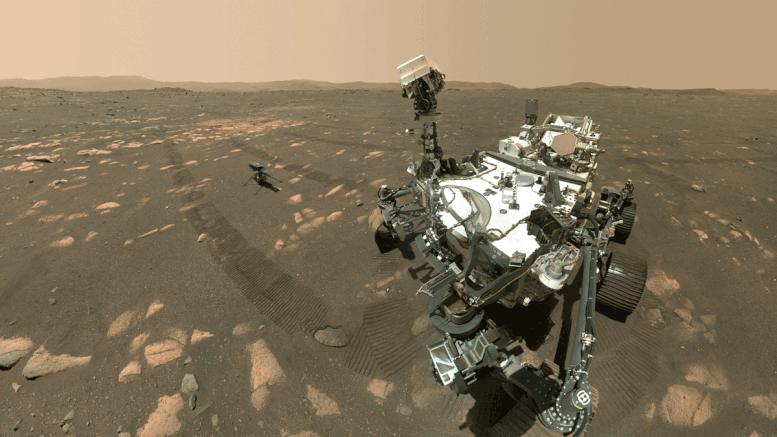
NASA’s Perseverance Mars rover took a selfie with the Ingenuity helicopter, seen here about 13 feet (3.9 meters) from the rover. This image was taken by the WASTON camera on the rover’s robotic arm on April 6, 2021, the 46th Martian day, or sol, of the mission. Credit: NASA/JPL-Caltech/MSSS
There has been concern about triboelectric charging because on Mars and the Moon, conditions are ideal for this to occur, especially in the soil. The soil is drier than desert sand on Earth, and when materials used on rover wheels – such as aluminum or steel – rub against the soil, it could create enough electric charge to create problems for the craft’s electronics. Therefore, grounding systems have been developed to counteract the issue.
But Ferrell and his team looked at the possibility of this happening for drones or rotocraft on Mars, as well, due to the dryness of the air, as well as the propensity of dust within the Martian air.
The scientists looked at how electric charge may accumulate on a drone’s rotor blades using computer modeling and laboratory experiments. They discovered that, particularly when the helicopter is close to the surface and blowing dust about, the drone’s blades may collide with the minute dust grains in the Martian air as they rotate.
As the blades impact the grains, charge is transferred, building up on the blades and creating an electric field. As charge builds to high levels, the atmosphere starts to conduct electricity, a process known as “atmospheric breakdown,” creating a population of electrons that form an enhanced electric current that acts to dissipate or offset the charge build-up on the rotorcraft.
Since the Martian atmosphere is extremely thin — at the surface just about one percent of the pressure of Earth’s atmosphere at sea level – this makes breakdown more likely. However, the researchers acknowledge that their result is a prediction, and sometimes nature has other plans.
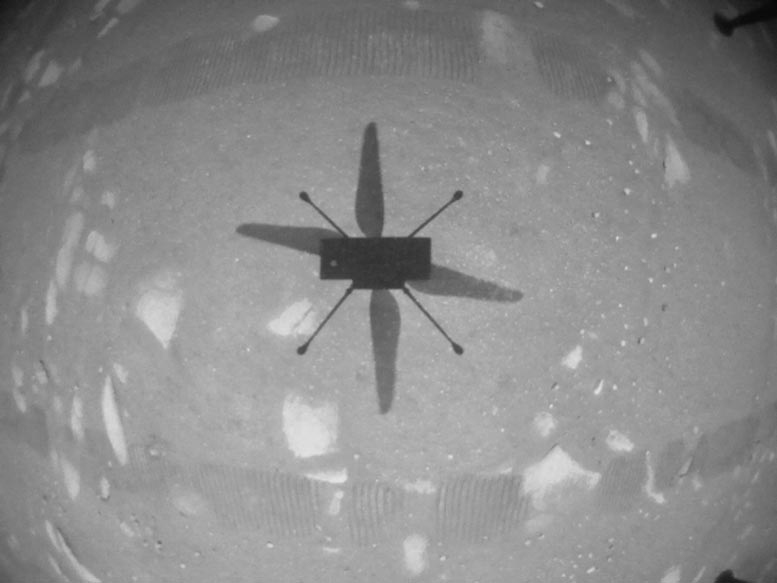
NASA’s Ingenuity Mars Helicopter captured this shot as it hovered over the Martian surface on April 19, 2021, during the first instance of powered, controlled flight on another planet. It used its navigation camera, which autonomously tracks the ground during flight. Credit: NASA/JPL-Caltech
“In theory, there should be some effect, but whether the electron avalanche is strong enough to create a glow, and if any weak glow is observable during operations all remain to be determined in future drone flights on Mars,” said Farrell “In fact, one could even place small electrometers up near the blade and at the legs to monitor the effects of any charging. This kind of electrical monitor could be of both scientific value and provide critical input on drone health during the flight.”
Adapted from an article originally published on Universe Today.
For more on this research, see Martian Atmospheric Breakdown: Helicopters Flying on Mars May Glow at Dusk.


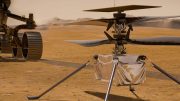
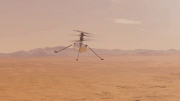

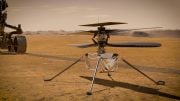
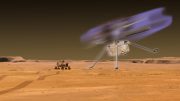
Be the first to comment on "Glowing Helicopters on Mars?"